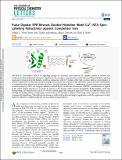Files in this item
Pulse dipolar EPR reveals double-histidine motif CuII-NTA spin-labelling robustness against competitor ions
Item metadata
| dc.contributor.author | Wort, Joshua | |
| dc.contributor.author | Arya, Swati | |
| dc.contributor.author | Ackermann, Katrin | |
| dc.contributor.author | Stewart, Alan J. | |
| dc.contributor.author | Bode, Bela Ernest | |
| dc.date.accessioned | 2021-05-06T16:30:16Z | |
| dc.date.available | 2021-05-06T16:30:16Z | |
| dc.date.issued | 2021-03-25 | |
| dc.identifier | 273246860 | |
| dc.identifier | 650e18da-b6aa-40e8-ad34-3b8d5eefa536 | |
| dc.identifier | 85103607709 | |
| dc.identifier | 000635441500016 | |
| dc.identifier.citation | Wort , J , Arya , S , Ackermann , K , Stewart , A J & Bode , B E 2021 , ' Pulse dipolar EPR reveals double-histidine motif Cu II -NTA spin-labelling robustness against competitor ions ' , Journal of Physical Chemistry Letters , vol. 12 , no. 11 , pp. 2815-2819 . https://doi.org/10.1021/acs.jpclett.1c00211 | en |
| dc.identifier.issn | 1948-7185 | |
| dc.identifier.other | ORCID: /0000-0003-4580-1840/work/90951871 | |
| dc.identifier.other | ORCID: /0000-0002-3384-271X/work/90951994 | |
| dc.identifier.other | ORCID: /0000-0001-7978-9507/work/90952164 | |
| dc.identifier.uri | https://hdl.handle.net/10023/23126 | |
| dc.description | Funding: JLW is supported by the BBSRC DTP Eastbio. We thank the Leverhulme Trust for support (RPG-2018-397). This work was supported by equipment funding through the Wellcome Trust (099149/Z/12/Z) and BBSRC (BB/R013780/1). We gratefully acknowledge ISSF support to the University of St Andrews from the Wellcome Trust. | en |
| dc.description.abstract | Pulse-dipolar EPR is an appealing strategy for structural characterization of complex systems in solution that complements other biophysical techniques. Significantly, the emergence of genetically encoded self-assembling spin labels exploiting exogenously introduced double-histidine motifs in conjunction with CuII-chelates offers high precision distance determination in systems nonpermissive to thiol-directed spin labeling. However, the noncovalency of this interaction exposes potential vulnerabilities to competition from adventitious divalent metal ions, and pH sensitivity. Herein, a combination of room-temperature isothermal titration calorimetry (ITC) and cryogenic relaxation-induced dipolar modulation enhancement (RIDME) measurements are applied to the model protein Streptococcus sp. group G. protein G, B1 domain (GB1). Results demonstrate double-histidine motif spin labeling using CuII-nitrilotriacetic acid (CuII–NTA) is robust against the competitor ligand ZnII–NTA at >1000-fold molar excess, and high nM binding affinity is surprisingly retained under acidic and basic conditions even though room temperature affinity shows a stronger pH dependence. This indicates the strategy is well-suited for diverse biological applications, with the requirement of other metal ion cofactors or slightly acidic pH not necessarily being prohibitive. | |
| dc.format.extent | 5 | |
| dc.format.extent | 1929610 | |
| dc.language.iso | eng | |
| dc.relation.ispartof | Journal of Physical Chemistry Letters | en |
| dc.subject | QC Physics | en |
| dc.subject | QD Chemistry | en |
| dc.subject | TK Electrical engineering. Electronics Nuclear engineering | en |
| dc.subject | DAS | en |
| dc.subject.lcc | QC | en |
| dc.subject.lcc | QD | en |
| dc.subject.lcc | TK | en |
| dc.title | Pulse dipolar EPR reveals double-histidine motif CuII-NTA spin-labelling robustness against competitor ions | en |
| dc.type | Journal article | en |
| dc.contributor.sponsor | The Leverhulme Trust | en |
| dc.contributor.sponsor | The Wellcome Trust | en |
| dc.contributor.sponsor | BBSRC | en |
| dc.contributor.sponsor | The Leverhulme Trust | en |
| dc.contributor.sponsor | The Wellcome Trust | en |
| dc.contributor.institution | University of St Andrews. School of Chemistry | en |
| dc.contributor.institution | University of St Andrews. Cellular Medicine Division | en |
| dc.contributor.institution | University of St Andrews. School of Medicine | en |
| dc.contributor.institution | University of St Andrews. Sir James Mackenzie Institute for Early Diagnosis | en |
| dc.contributor.institution | University of St Andrews. Biomedical Sciences Research Complex | en |
| dc.contributor.institution | University of St Andrews. Institute of Behavioural and Neural Sciences | en |
| dc.contributor.institution | University of St Andrews. EaSTCHEM | en |
| dc.contributor.institution | University of St Andrews. Centre of Magnetic Resonance | en |
| dc.identifier.doi | 10.1021/acs.jpclett.1c00211 | |
| dc.description.status | Peer reviewed | en |
| dc.identifier.grantnumber | RPG-2018-397 | en |
| dc.identifier.grantnumber | 099149/Z/12/Z | en |
| dc.identifier.grantnumber | BB/R013780/1 | en |
| dc.identifier.grantnumber | RPG-2017-214 | en |
| dc.identifier.grantnumber | en |
This item appears in the following Collection(s)
Items in the St Andrews Research Repository are protected by copyright, with all rights reserved, unless otherwise indicated.

